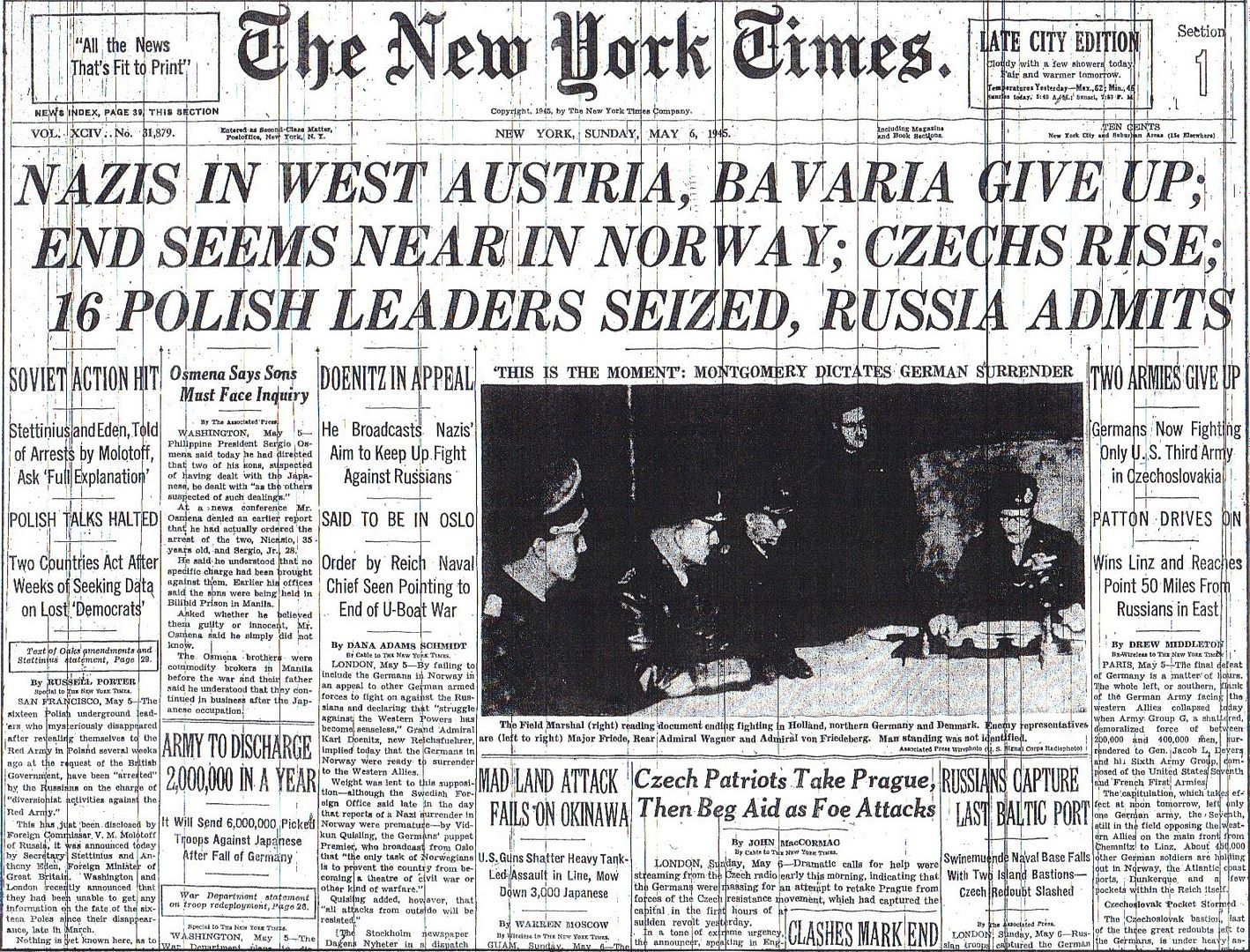
Posted on 05/06/2015 4:29:56 AM PDT by Homer_J_Simpson

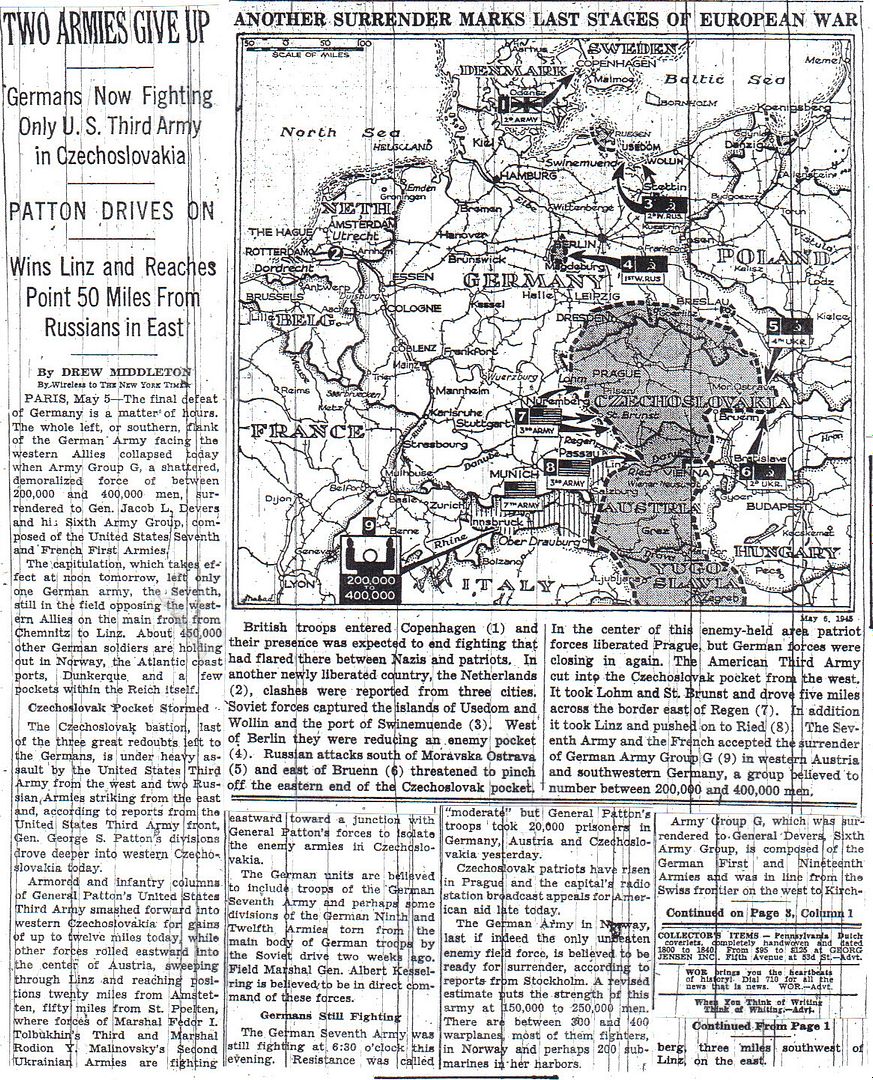
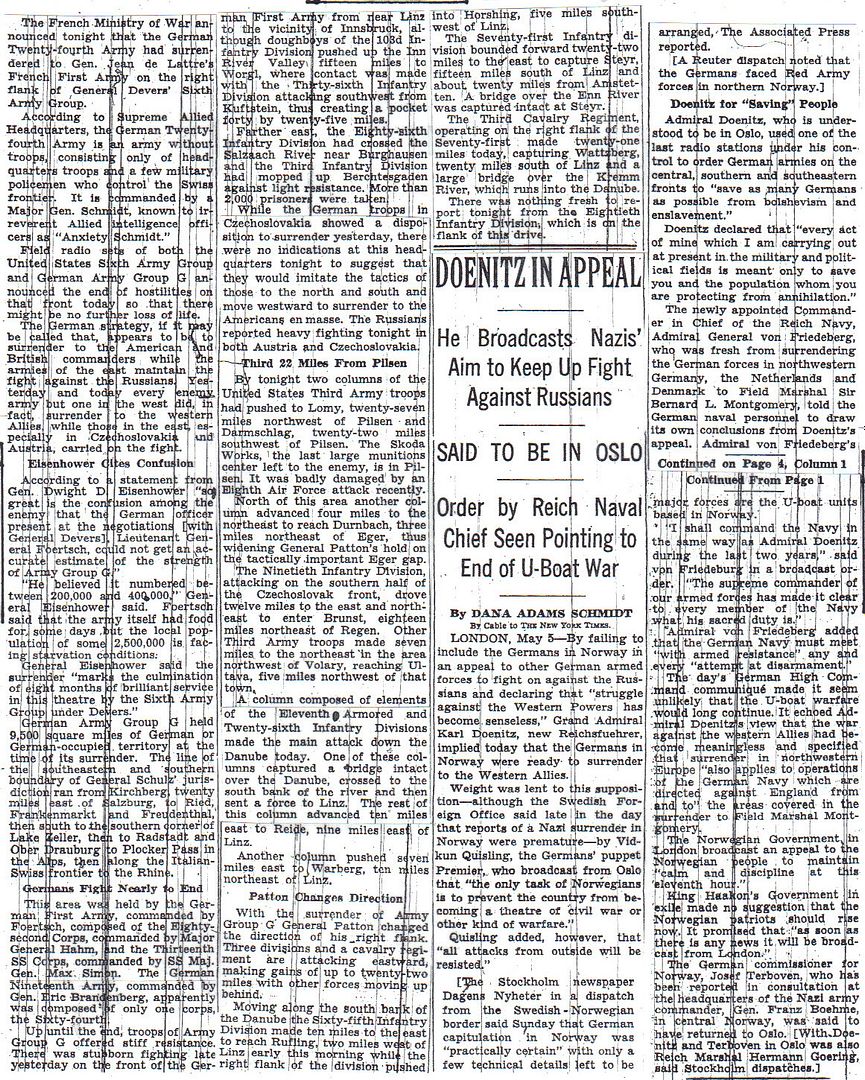

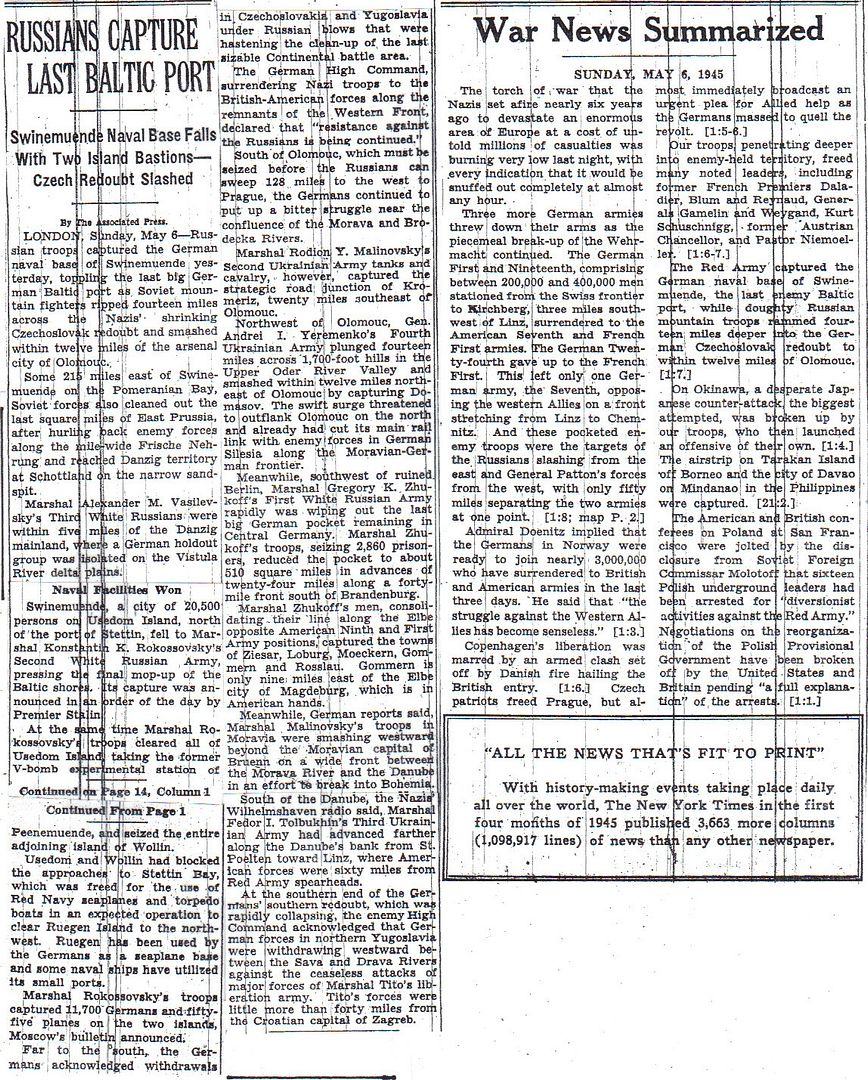
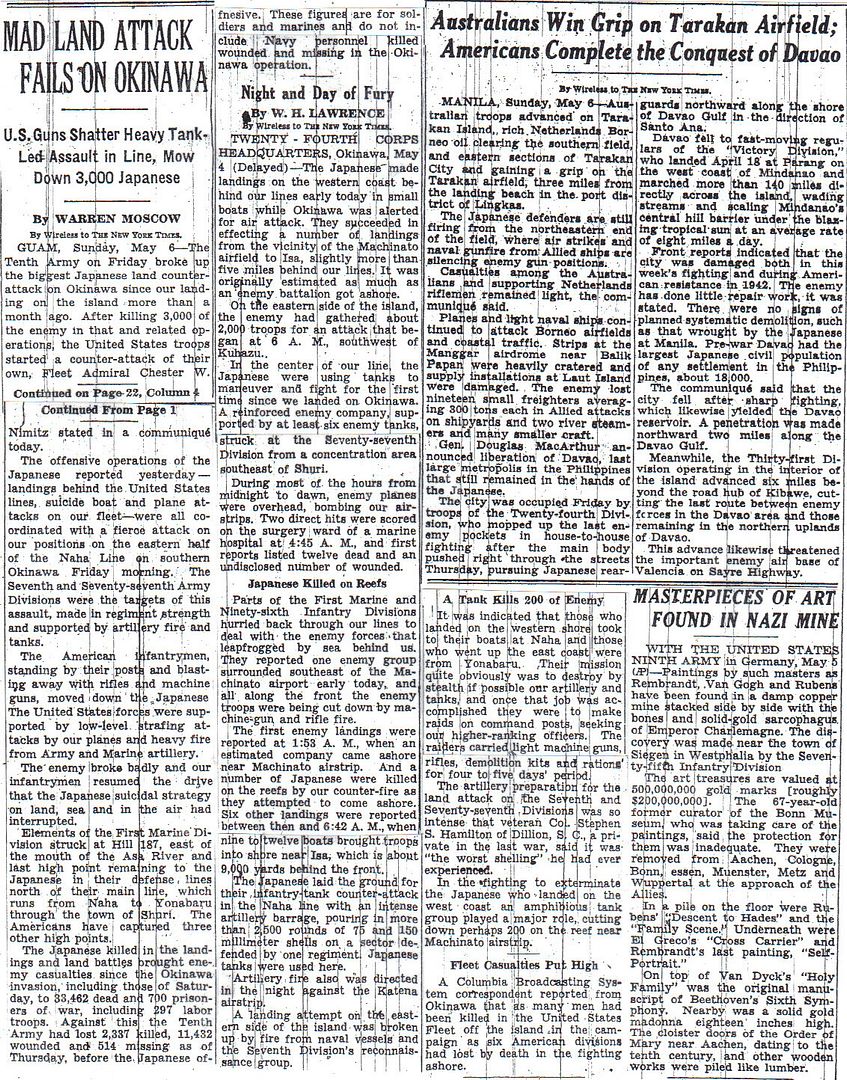
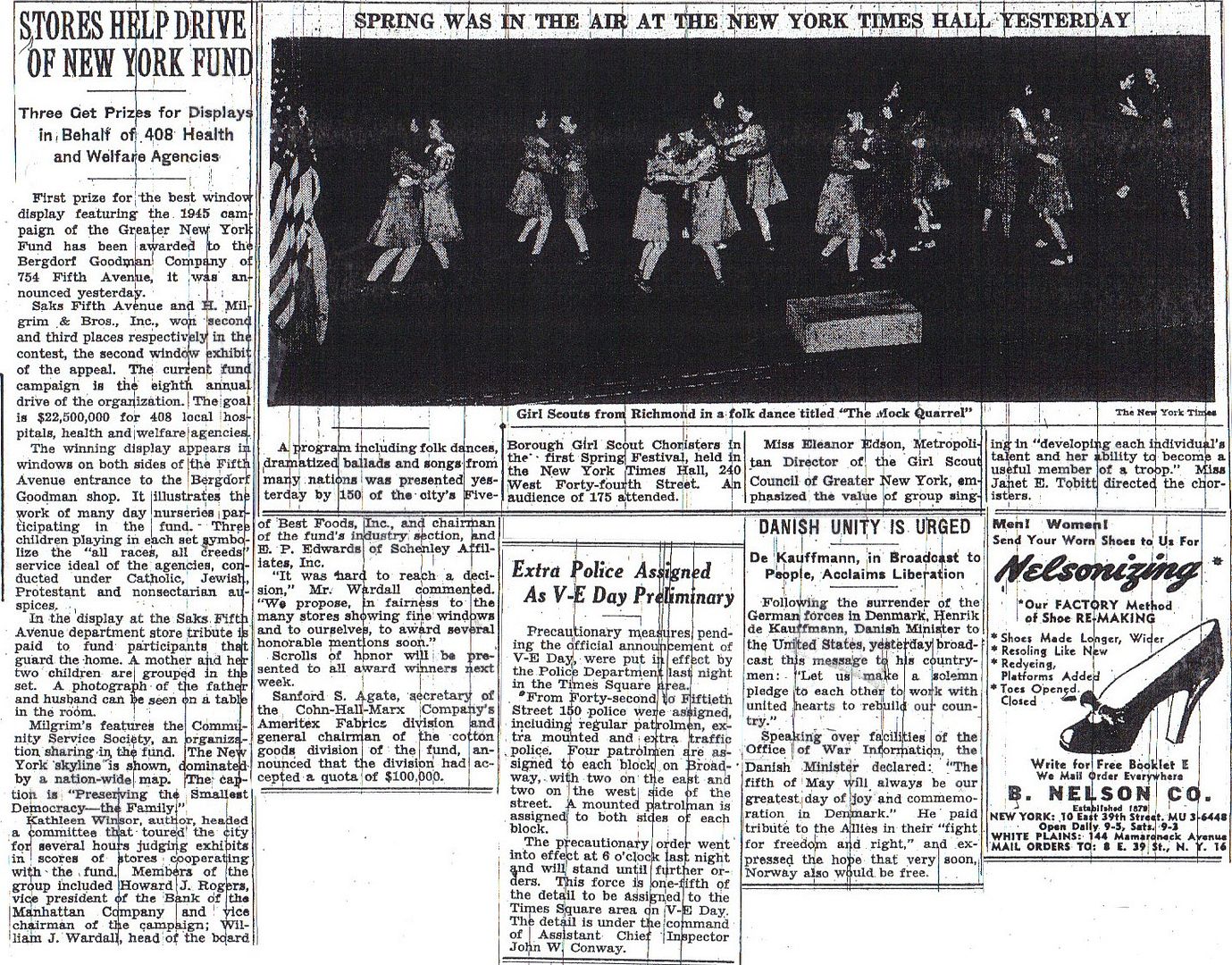
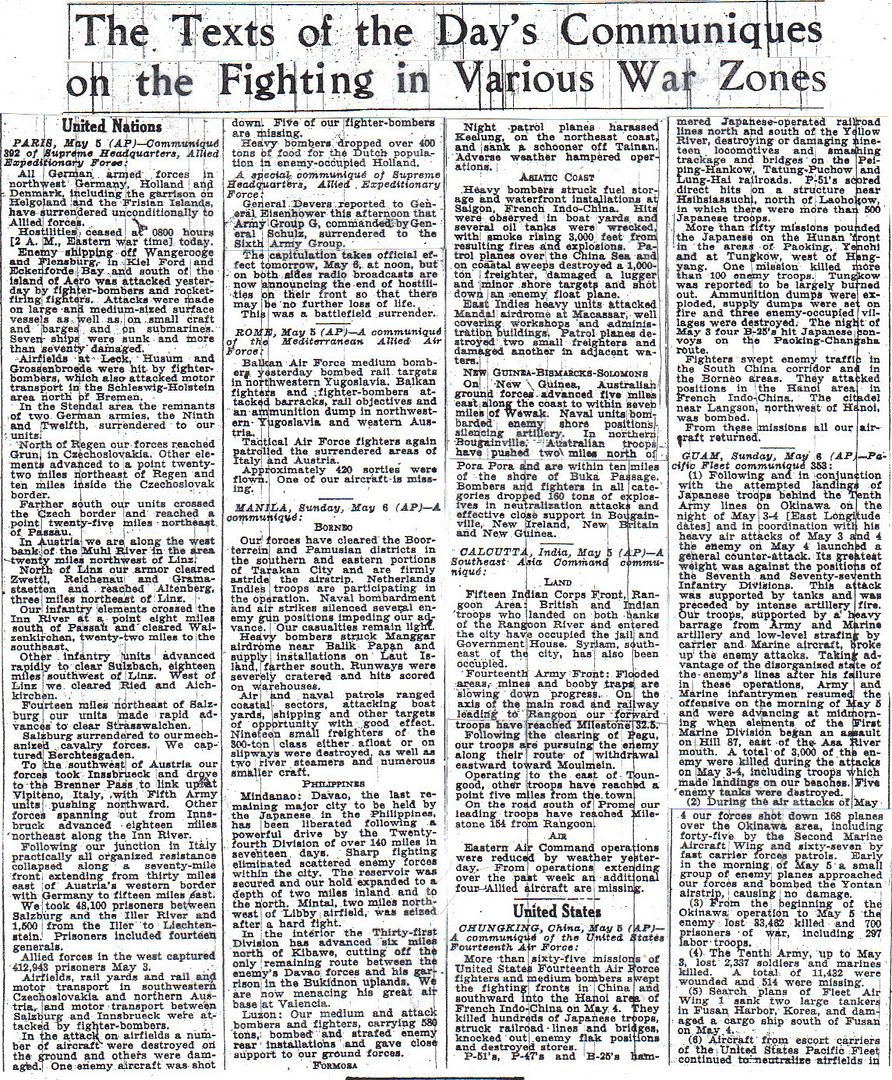

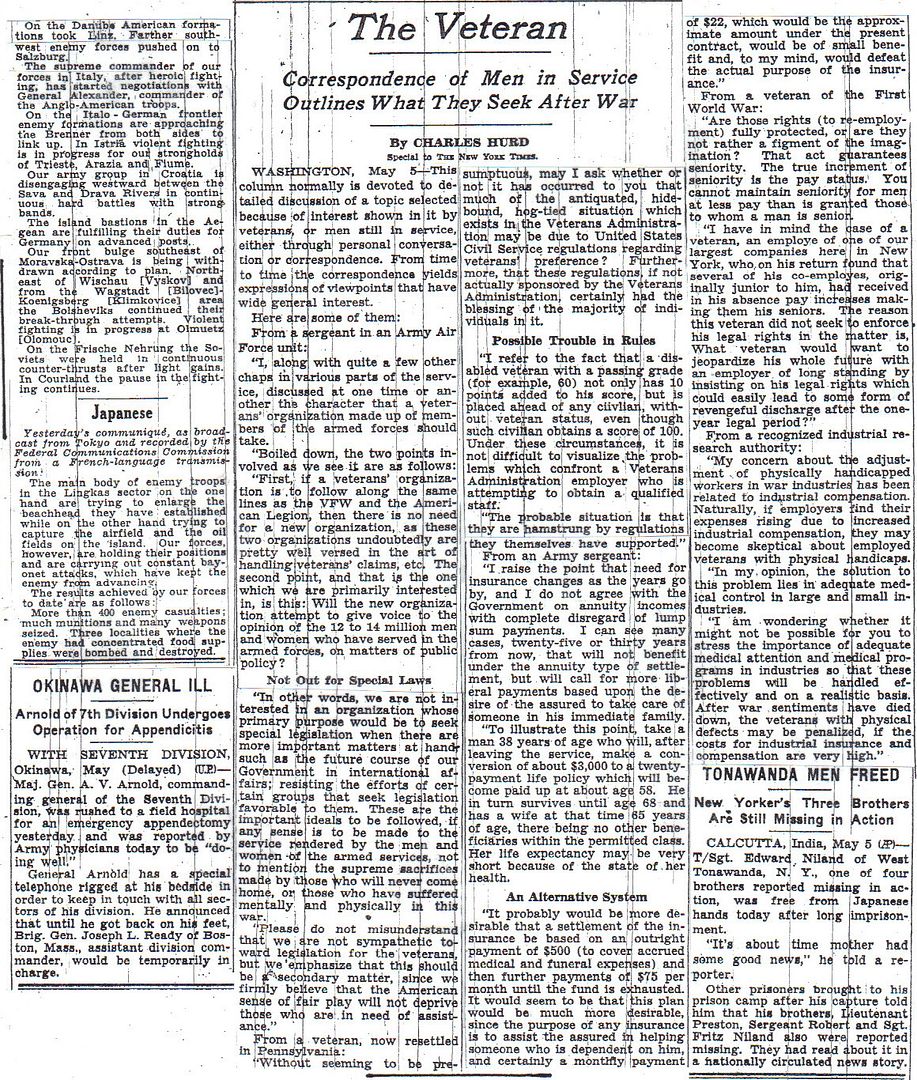
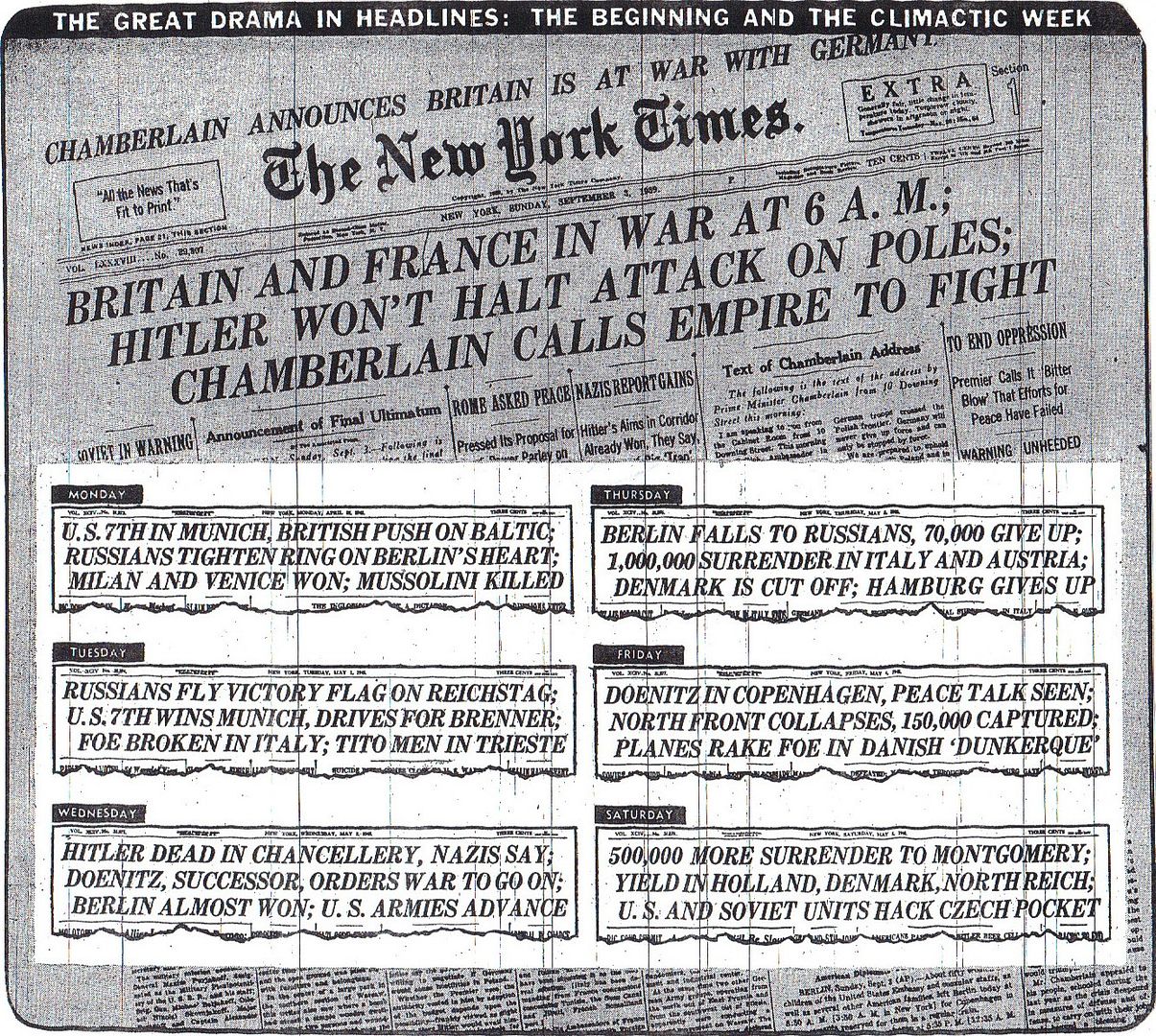
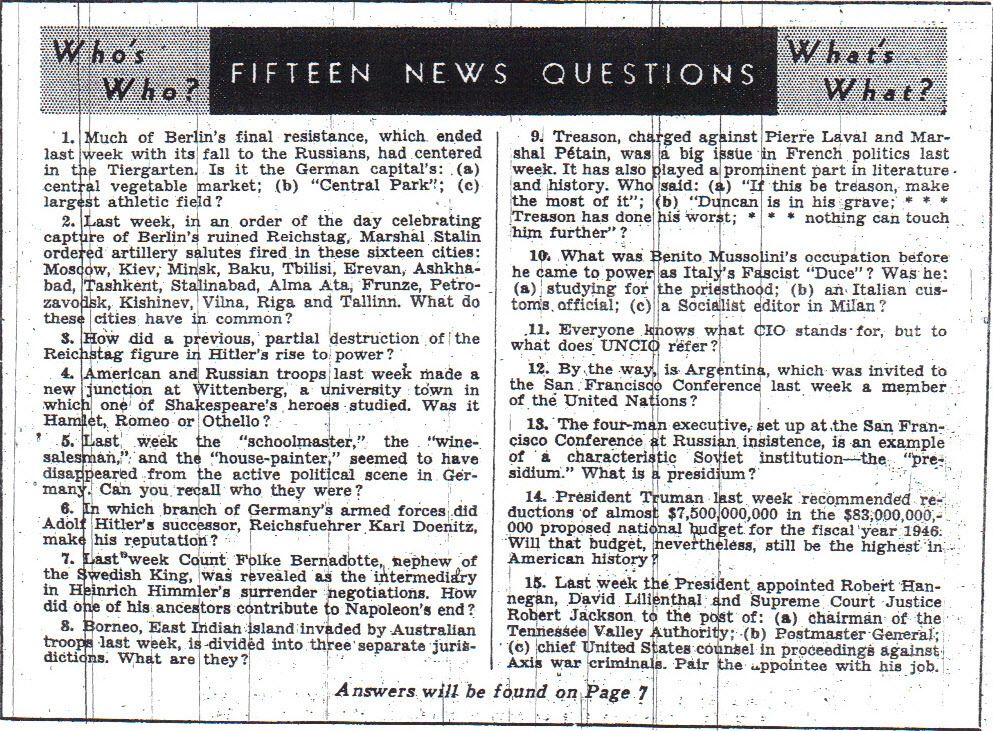

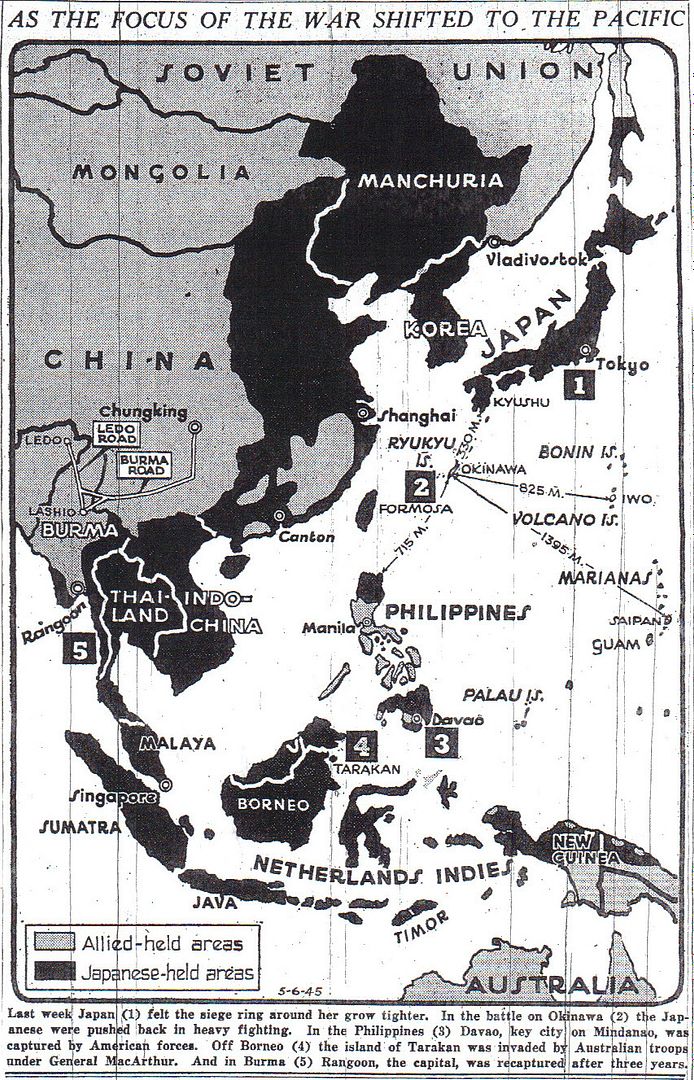
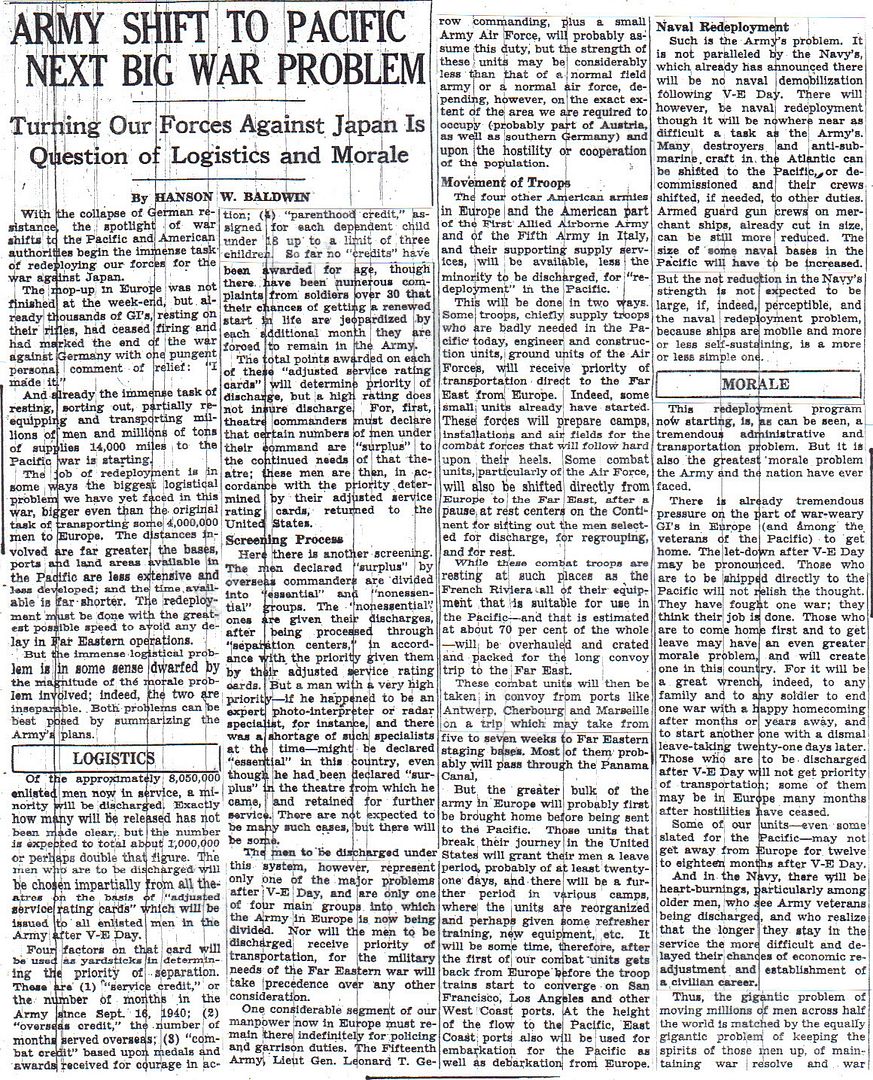

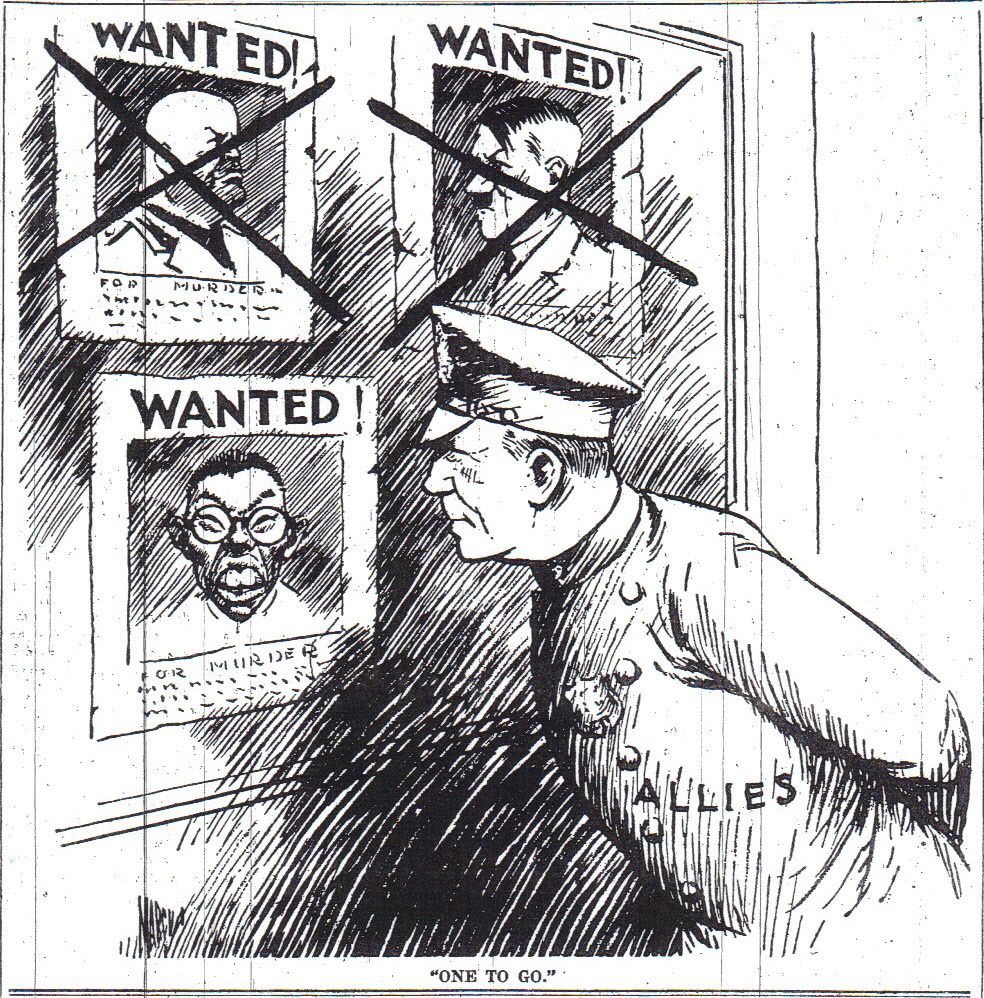
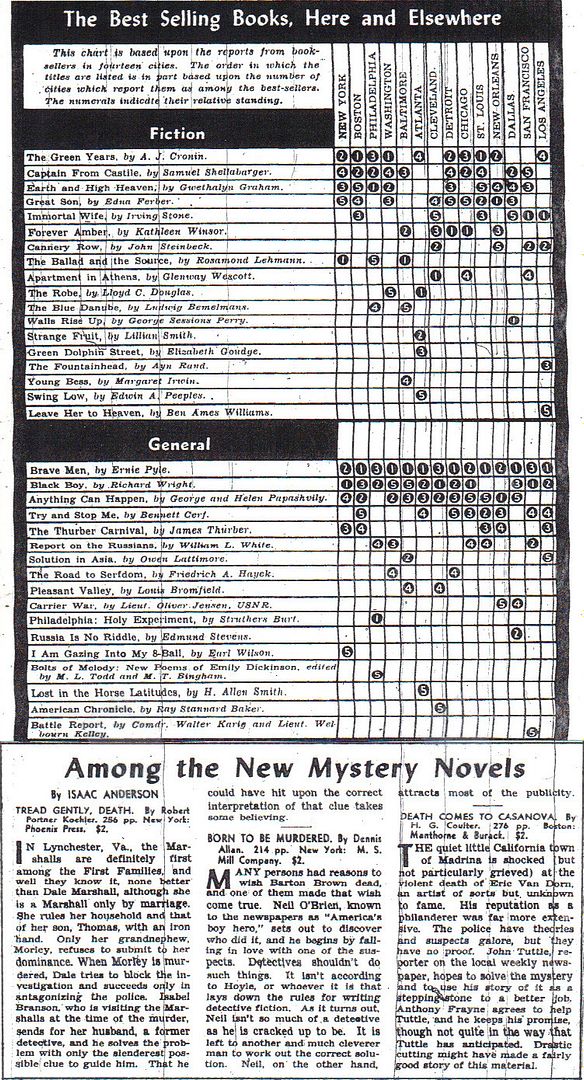
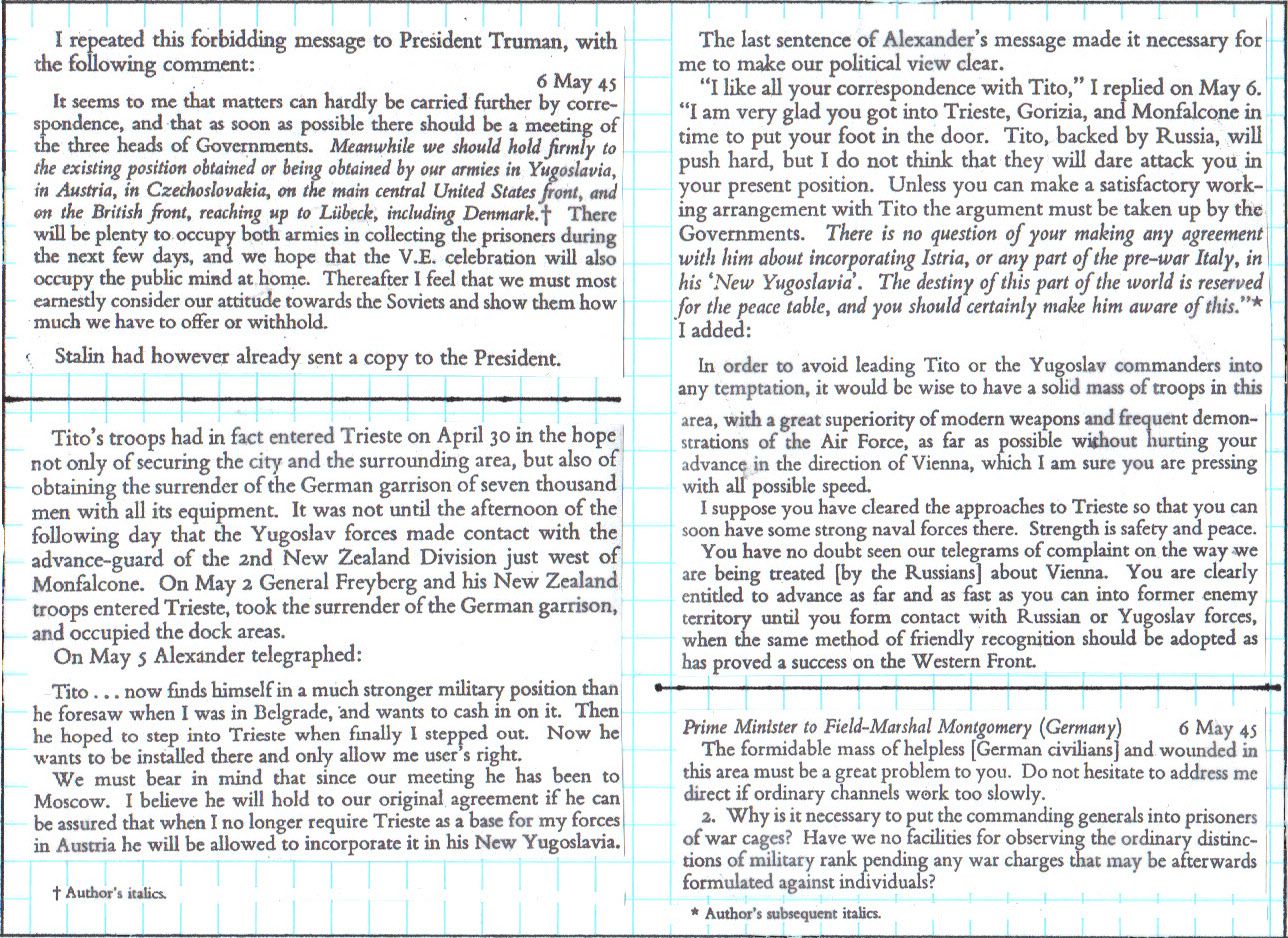
Winston S. Churchill, Triumph and Tragedy
The News of the Week in Review
The Great Drama in Headlines: The Beginning and the Climactic Week (graphic) – 11
Fifteen News Questions – 12
The Pulse of the War: A Chart Showing the Fluctuations of Allied Hopes for Victory – 13
As the Focus of the War Shifted to the Pacific (map) – 14
Army Shift to Pacific Next Big War Problem (Baldwin) – 15-16
“The Next Big Link-Up” (cartoon) – 16
Answers to Fifteen News Questions – 16
“One to Go” (cartoon) – 17
The New York Times Book Review – 18
The Best Selling Books Here and Elsewhere
Among the New Mystery Novels (Reviews by Isaac Anderson)
http://www.etherit.co.uk/month/4/06.htm
May 6th, 1945 (SUNDAY)
GERMANY: Dönitz sacks Himmler from all offices.
NORWAY:
The Hopseidet Incident.
[Story Continued from the 5th]
On the 6th, between two and three o’clock, the Germans went ashore, and fire was opened from the defenders. After some heavy fire from machineguns the defenders were forced to retire. Only one man stayed behind on the beach; the “Bergen-man” Henry Mohr was hiding behind some big rocks while he was responding the fire with his light arms. When he finally ran out of ammo, he stretched his arms up and surrendered. He was badly mistreated by the Germans, but for some reason not shot. Together with the “guide” Ivar ÿye was taken aboard the sub.
Another fisherman was also wounded by the Germans. Mathis Persen had been hit in the knee early in the fight. He was laying in agony on a small grass-field close to the beach. A German soldier approached him, looked at his knee, shook his head and pointed his gun against his head. Persen begged for his life, the German put away his gun and put a bandage to Persens knee. Twice he went back with his gun lifted, but finally left the wounded man.
The Germans concentrated their energy elsewhere; all livestock they could find was gathered and shot. All the buildings who was in such a state that people could take shelter or live in, were blown up (It is necessary to remember that all houses were burned as the Germans redrew from the county in autumn 1944, and these houses were just improvised structures).
Sigurd Ferman was one of the witnesses to what happened. The Germans were leading six fishermen, who were taken prisoner as they were trying to make it for the mountains, towards the only building left in the village, a warehouse. The fishermen were lined up with their hands above their heads, and three Germans lined themselves up against them with their weapons ready. Just before the weapons were fired, the witness Ferman could hear one of the fishermen shout:” Are you firing at civilians.?” Ferman was stunned as he watched the six fishermen being executed. The victims were screaming. An officer then gave them coup de grace with his bayonet.
Two of the soldiers went inside and searched the building. It later showed that two of the fishermen had knives placed in their hands to make it look as they had been armed. Ferman identified the knives and knew that they were taken from the warehouse.
In the cellar of a cowshed Caroline Mikalsen were hiding with nine of her eleven children, the youngest only 4 months old. One daughter was away, and her husband and the eldest son were among the executed fishermen. The Germans become aware of the hideaways, and one soldier went inside the cowshed and fired his weapon through the roof, above which some of the children was hiding and nearly hit by the bullets. The eldest daughters were hiding inside a cupboard.
Caroline asked for mercy, but the soldier said triumphant that her husband and son were shot, and then he raped her with the children watching. As he left the cowshed, he threw a hand grenade in through a window. It landed in a basket of clothes and did not explode. One of her sons later carried the basket down to the sea.
After this the Germans went back to the beach. The loudspeakers on the subs played march-music, and a voice declared that Hopseidet was taken without German casualties, and that six enemies were fallen. The soldiers embarked the subs, and accompanied by loud music they left and were soon out of sight.
To the six bodies by the warehouse were attached propaganda-posters. The wounded man Mathis Persen was still laying down by the shore. Caroline Mikalsen heard his call for help and found him by rowing slowly along the shore. Her 14-year old son and herself carried the wounded, now unconscious man into shelter. Her nursing saved Persens life until the doctor arrived.
At 5 o’clock the following day Norwegian troops arrived at Hopseidet only to find that six innocent civilians lives were lost. Half an hour later the Germans in Norway surrenders, Hopseidet became the last German military action in Norway.
Later two German soldiers were put to trial in West-Germany, accused of the misdeed, but the case was dismissed in 1969. The soldiers claimed self- defence, and a Norwegian trial was never stated.
On the scene of the misdeed a memorial has been placed, bearing the following inscription:
“In memory of six civilian unarmed fishermen, mishandled and shot by the Germans the 6. May 1945.
Leonard Eriksen 35 years
Einar Mikalsen 47 years
Johan Mikalsen 18 years
Harald Kristiansen 39 years
Henry Kristiansen 16 years
Reidar Karlsen 17 years
The German U-Boats involved were the “U-318” and the “U-992”, which landed a platoon of Kleinkampfverbände 35 under command of Korvettenkapitän Wolfgang Woerdermann at Hopseidet, near Gamvik in Finnmark county, 6th May, 1945. They executed six unarmed Norwegian civilians as well as committing other crimes. Both U-boat captains were tried after the War, but were found not guilty as the crimes committed were not committed by the U-boat crews. (Torstein Saksvik)
CZECHOSLOVAKIA: Pilsen is liberated by the US 3rd Army, but is ordered to stay there to allow the Russians to occupy the rest of the country.
Prague: The 1st Division of the POA join the fight with the Czech patriots against the remaining German SS units. By the evening the city is clear of SS.
Lisbon: PORTUGAL severs diplomatic relations with Germany.
BURMA: The British 26th Indian Division mops up in the area north of Rangoon.
INDIAN OCEAN: The battleships and cruisers of TF 63 shell Port Blair in the Andaman Islands.
RN 804 Sqn Hellcat a/c #JX803 ditched port side of ship during Operation “BISHOP” strikes on the Nicobar and Andaman Islands off Port Blair in the Indian Ocean. Pilot lost.
SINGAPORE: U-181 and U-862 taken over by Japan and became the Japanese submarine I 502 15 July 1945.
NETHERLANDS EAST INDIES:
U-195 is taken over by the Japanese at Soerebaja.
U-219 is taken over by the Japanese at Batavia.
OKINAWA: The Japanese counteroffensive fizzles out with heavy losses. This confirms US gains at Maeda Ridge and Marchinto Air Field.
Off Okinawa, kamikazes damage the surveying ship USS Pathfinder (AGS-1) and the seaplane tender USS St. George (AV-16).
PACIFIC OCEAN: Naval landing force evacuates 500 Marshallese from Jaluit Atoll, Marshall Islands.
U.S.A.: Heavy cruiser USS Toledo launched.
ATLANTIC OCEAN: Destroyer escort USS Atherton, while en route from New York to Boston, encountered a U-boat. After four depth charge attacks, pieces of broken wood, cork, mattresses, and an oil slick broke the surface. Atherton, in conjunction with frigate USS Moberly, was later credited with destroying U-853.
U-881 sunk in the North Atlantic SE of Newfoundland, in position 43.18N, 47.44W, by depth charges from destroyer escort USS Farquhar. 53 dead (all hands lost).
U-1008 sunk in the Kattegat north of Hjelm Island, in position 56.14N, 10.51E, by depth charges from an RAF 86 Sqn Liberator. 44 survivors (No casualties)
U-3523 sunk at 1839hrs in the Skaggerak east of Århus, Denmark, in position 57.52N, 10.49E, by depth charges from an RAF 86 Sqn Liberator. 58 dead (all hands lost).
"The Allies often forced captured German soldiers to exhume victims of the Holocaust so that their corpses could be buried under more sanitary conditions.
Here, several German POWs unearth a mass grave at Kaufering III.
The Kaufering camps, 11 in all, were subsidiaries of the Dachau, Germany, camp.
The Nazis intended for prisoners to build fighter-aircraft factories, a program that never developed.
Thousands of Kaufering inmates died from disease, overwork, malnutrition, or execution, and their bodies were dumped like garbage."
"Anton Mussert (with hat) was the leader of the Nationaal-Socialistische Beweging der Nederlanden (Dutch Nazi Party).
Although a firm supporter of the Nazis, he had very little influence over events during the long years of occupation.
Hitler had no respect for him.
On May 7, 1945, he was arrested by the Dutch Resistance.
Mussert was executed exactly one year later."
"On April 29, 1945, Hitler chose Admiral Karl Dönitz (pictured) as his successor, naming him president and supreme commander of what remained of Germany's armed forces.
The Führer was convinced that the SS, the Wehrmacht, and the Luftwaffe had betrayed him.
Only the German Navy, which had long ceased to be a factor in the war, seemed to Hitler to be untainted.
Further, Heinrich Himmler and Hermann Göring had broken with the regime and attempted to strike separate deals with the Allies in futile attempts to save their skins.
So Dönitz succeeded Hitler mainly by default.
During the 23 days that President Dönitz led Germany, he perpetuated Hitler's anti-Soviet policies.
Found guilty at Nuremberg on counts of waging aggressive war and war crimes, Dönitz was sentenced to ten years' imprisonment."
"With a bronze bust of Adolf Hitler tucked under his arm, a Soviet soldier celebrates the taking of the Berlin Reich Chancellery building.
The last German forces, mostly old men and young boys of the Hitler Youth, could do little to hold back the vast Soviet Army.
Berlin fell on May 2, and on May 7, at a schoolhouse near Reims, France, the German forces unconditionally surrendered.
Nearly six years of European war--and death and devastation without parallel in history--had ended."
"Celebrating their hard-fought victory, a soldier raises a Soviet flag from the roof of the Reich Chancellery, the seat of Nazi power, now occupied by the Soviet Army.
Under the leadership of war-hardened Generals Zhukov and Konev, the Soviet Army swept into the city.
Frightened citizens of Berlin, fearing retribution, sought to flee the devastated capital."
"SS troops in Copenhagen, Denmark, turn over their weapons before surrendering.
The long years of conflict had taken their toll.
Recognizing that the war was lost, these soldiers respond with joy to the order to proceed to the British lines, knowing that they had survived a war that many of their comrades had not."
"Liberation was welcomed by every prisoner -- although those who had collaborated with the Nazis had qualms about their altered situations.
This Polish slave laborer (left) who relaxed on May 4, 1945, with a young companion, in quarters that had been occupied by the adjutant of the Flossenbürg, Germany, concentration camp, was later accused of being a Kapo who had mistreated the camp's Jewish prisoners."
"Symbolic victories over their erstwhile captors were often important to camp prisoners.
Here, for example, some of the former prisoners of the concentration camp at Mauthausen, Austria, tear down the Nazi eagle and swastika over the camp's main gate.
Former inmates had suffered Nazi terror in horrifyingly unique ways, and were eager to destroy physical reminders of the Third Reich.
It was left to some Allied soldiers, who encountered German troops mainly as battlefield adversaries, to regard Nazi artifacts as souvenirs to be gathered and kept."
"The Allies often made practical--and ironic--use of the former concentration camps to house German prisoners of war.
This British soldier stands watch over German POWs being held in what had been the Neuengamme concentration camp."
Chuck Norris was born on May 6, 1945.
Now I know the Germans are doomed! :-)
May 6, 1945 - Tying Up The Loose Ends In Europe.
Fifteen minute newscast, delivered by Paul Manning of Mutual Braodcasting
http://crooksandliars.com/gordonskene/may-6-1945-tying-loose-ends-europe
With news of the end of hostilities in Europe hours, if not days away, news was still coming in of fighting continuing in Germany and points East, even as German armies throughout the European theater were surrendering. As this direct report from Paris indicates, complete surrender was only a matter of time and the flood of refugees fleeing Berlin in the wake of advancing Russian armies made clear a new reality about to settle over Europe - the long road back to anything resembling normal.
In this fifteen minute newscast, delivered by Paul Manning of Mutual on May 6th 1945, anticipation of U.S. troops coming home was high, and the business of occupation by Allied forces was underway.
Another day in May spent waiting for an outcome.
Surrender of Luftwaffe Wing, Ampfing, Germany (May 6, 1945)
https://www.youtube.com/watch?v=1_3bPSgyVmg
Pilsen: Liberation By the US Army on May 6 1945
http://www.cv6.org/1945/1945.htm
USS Enterprise
...On the 6th [of May], as the Big E steamed northwest, 350 Kamikazes attacked TF 58, sinking three ships. Over the next six weeks, suicide attacks sank another 33 ships and damaged 368 others...
Nazi concentration camp Ebensee liberated 70 years ago today (May 6 1945)
(Sunday, May 6, 1945) — The Ebensee concentration camp, established to build tunnels for armaments storage near the town of Ebensee, Austria, as part of the Mauthausen network, was liberated today by American forces.
Approximately 20,000 inmates were worked to death constructing giant tunnels in the surrounding mountains. Together with the Mauthausen subcamp of Gusen, Ebensee is considered one of the most horrific Nazi concentration camps.
Two horrific videos:
V-CN Day.
The Battle of Point Judith, May 6, 1945
...Not far from the lighthouse is a small plaque dedicated to twelve merchant mariners who died just hours before the end of hostilities in May 1945. And on it’s black surface is the story of the last battle of the Atlantic War...
...At 1755, just fifteen minutes after the torpedo struck, the Black Point settled rapidly by the stern, rolled over to port, and disappeared beneath the waves. Of the crew of forty-one merchant seamen and five armed guards, twelve men were dead.40 But, as she died, Radio Officer Tharl’s message sped through the airwaves....
Read the whole story here:
http://www.desausa.org/de_photo_library/battle_of_point_judith.htm
I saw yesterday that LTC Creighton Abrams got his long awaited and well-deserved promotion to Colonel.
And Hanson Baldwin addresses the question hanging over every ETO G.I.'s mind - and his family's - transfer to the Pacific.
If I remember right, the plan all along had been for the Americans to help Monty if needed.
And at this point, it isn’t as if Ike didn’t have a Corps to spare.
;-)
http://www.historylink.org/index.cfm?DisplayPage=output.cfm&file_id=11046
Colonel Burton Andrus assumes command of Nazi-war-crimes interrogation center and holding facility on May 6, 1945.
On May 6, 1945, U.S. Army Colonel Burton C. Andrus (1892-1977) becomes commandant of a new prison holding senior Nazi leaders facing war-crimes trials following Germany’s defeat in World War II. The interrogation center and holding facility is initially located in a former hotel in Mondorf les Bains, Luxemburg. In August 1945 the prisoners will be moved to a prison in Nuremberg, Germany, adjacent to the Palace of Justice, where International Military Tribunal trials (often known as the Nuremberg trials) will begin on November 20, 1945. Andrus will command the Nuremberg prison and, following two suicides, will attempt to make the jail suicide-proof. However, security features Andrus institutes will not prevent Hermann Goering from killing himself hours before he is to be hanged. Andrus will be relieved of duty following Goering’s suicide and for the rest of his life will blame himself for Goering’s escape from the hangman...
Disclaimer: Opinions posted on Free Republic are those of the individual posters and do not necessarily represent the opinion of Free Republic or its management. All materials posted herein are protected by copyright law and the exemption for fair use of copyrighted works.